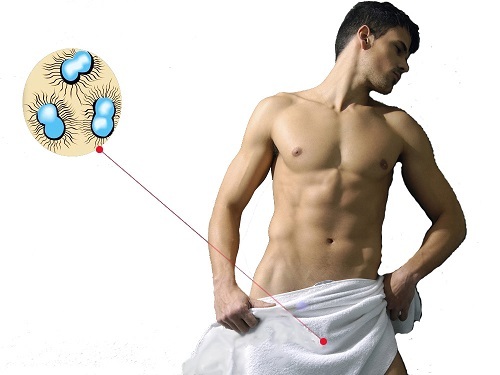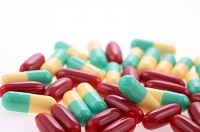Many sexually transmitted diseases do not manifest themselves instantly, that is right after intercourse. There is an incubation period when the relative time( days, weeks) must pass between the infection or bacteria entering the human body and the first clinical manifestations of the disease. Such diseases include gonorrhea in men, which develops in several forms.

What is gonorrhea?
Gonorrhea is considered to be an infectious disease that is caused by gonorrhoea. Infection can only be transmitted sexually with mandatory damage to the mucous membrane of the genitourinary organs, in some cases spreads to the mucosa of the rectum, the oral cavity and the conjunctiva. Any lesion of the mucosa leads to a purulent inflammatory process and leads to the development of:
- urethritis;
- of cervicitis;
- salpingitis;
- proctitis;
- of arthritis;
- conjunctivitis and other diseases.
The source of infection can be an infected person, it is extremely rare for infection to occur through household items( such as underwear, bath towel, washcloth).About the domestic infection is said extremely rarely, due to:
- rapid death of the gonococcus outside the human body in the absence of favorable conditions for its development;
- inadequate number of gonococci for infection.
Given this, swimming pools, public toilets, saunas, general utensils, can not be considered the main source of infection. The most likely oral route of infection, when a partner or partner is ill with oral or urogenital gonorrhea. In more complicated cases, the infection can be transmitted to the child at his birth, through the infected genitalia of the sick mother.
How is gonorrhea manifested?
About the first clinical manifestations of the disease the patient guessed 3-7 days after infection, such is the incubation period of the gonococcus. With a high resistance of the organism to pathogens of various diseases, symptoms can disturb the patient only after a couple of weeks. The disease is characterized by two forms of percolation: acute and chronic. In acute gonorrhea, the patient is concerned: 
- secretions of mucus and pus:
- with unpleasant sensations of burning and pain in the urethra;
- frequent and painful urge to urinate.
In the absence of timely treatment, the infection penetrates the urethra, the infection penetrates into the epididymis, causing its inflammation( we are talking about epididymitis and orchoepididymitis).Inflammatory process leads to an increase in the testicle, accompanied by extreme soreness and fever. After several( 3-4) weeks, the inflammatory process either passes or passes into a chronic form. In more complicated cases, the third( latent) form of gonorrhea may be necrosis.
Symptoms of chronic form of gonorrhea are often less pronounced, because of which the patient delays a visit to a urologist or a venereologist. In contrast to the acute form of chronic is considered the most dangerous, since the absence of sometimes symptoms leads to neglect and complications.
Complications of gonorrhea
The absence of treatment in chronic form leads to the fact that the disease subsequently spreads to the bladder, ureters, causing inflammation of the kidneys. In addition, complications appear in the form of inflammation, extending to the head of the penis, the inner sheet of the foreskin, the gland of the urinary duct, the paraurethral canal. Serious are considered complications in the form of inflammatory processes of seminal vesicles( vesiculitis) and epididymis( epididymitis), as well as narrowing the lumen of the urethra.
Against gonorrhea vesiculitis develops sharply and is accompanied by such symptoms as:
- temperature increase;
- the appearance of dull pain in the groin, sacrum, anus, which are intensified by the process of urination and defecation;
- chills;
- increased fatigue;
- headache;
- frequent urination;
- nocturnal erections;
- discharge with blood sperm.
With epididymitis, as one of the types of complications of gonorrhea, the body temperature rises to 39-40 degrees, redness and swelling of the scrotum are observed, the patient is disturbed by so strong pain in the testicle that sometimes he deprives the ability to move. If two testicles are affected, the consequences are irreversible and characterized by the development of prostatitis, impotence and infertility.
Diagnosis in gonorrhea
For the diagnosis of some clinical manifestations of the patient is not enough. The doctor is guided by the results of microbiological diagnosis and laboratory studies. This approach is based on the fact that gonorrhea in men is similar in its symptoms to other infectious diseases, passing sexually.
Microbiological diagnosis consists of the following methods:
- bacterioscopic( microscopic);
- bacteriological;
- serological;
- molecular biological.
Bacterioscopic method consists in the staining of two Gram stains, as well as 1% aqueous solution of methylene blue and 1% alcohol solution of eosin. The bacteriological method consists in sowing on nutrient media and makes it possible to assess the sensitivity of gonococci to antiviral drugs. The serological method consists in carrying out the RSK( complement fixation reaction) using the patient's blood serum. The molecular biological method is characterized by a high sensitivity and specificity index.
Laboratory tests for gonorrhea consist of:
- total smear;
- method for detection of pathogen antigens;
- method for detecting the DNA of the pathogen;
- sowing;
- reveals antibodies to the causative agent.
A common smear, or smear on the flora, consists in examining the discharge from the urethra and allows you to determine the number of leukocytes. Based on the number, you can judge the presence or absence of the inflammatory process. To implement the method of identifying the pathogen antigens, also the discharge from the urethra is used. The method of DNA detection of the pathogen includes a polymerase chain reaction and allows the diagnosis with maximum accuracy of chronic and asymptomatic infections.
The essence of sowing is the application of the test material to such nutrient media that are recognized as suitable for the growth of pathogenic microorganisms. For sowing, discharge from the urethra is used. The method is unique to high accuracy, but takes a lot of time - from 7 to 10 days. To conduct methods for detecting antibodies to the pathogen, the patient's blood is used.
Fighting gonorrhea
Given the incontrovertible fact that one of the consequences of gonorrhea may be infertility, the patient should immediately and urgently turn to the venereologist to undergo competent treatment. Treatment of gonorrhea should be performed by a doctor, whose duties include an individual selection of the treatment regimen and constant monitoring of the patient's condition in dynamics. Self-medication with the help of antibacterial drugs is not recommended, since it is possible to form the drug resistance in bacteria and the transition of the disease to a chronic form.
An easy form of gonorrhea is treated on an outpatient basis. Treatment of the disease consists of antibiotic therapy aimed at the complete destruction of the pathogen of infection - gonococcus. A competent specialist is obliged to warn the patient about the fact that before the beginning of treatment( within a few days) any sexual contacts were excluded and the consumption of alcoholic and alcoholic drinks is limited.
The basis of antibacterial therapy is the antibiotics of the penicillin group. These are benzyl-penicillin,  amoxicillin, oxacillin, the most effective and frequently used antibiotic in gonorrhea. In cases where the described drugs are contraindicated to the patient for any reason or are ineffective, cephalosporins( "cefataxime", "cefaclor", "cefazolin", "ceftriaxone"), macrolides( "Azithromycin", "Josamycin"), fluoroquinolones("Ciprofloxacin", "Lomefloxacin", "Levofloxacin", "Ofloxacin").
amoxicillin, oxacillin, the most effective and frequently used antibiotic in gonorrhea. In cases where the described drugs are contraindicated to the patient for any reason or are ineffective, cephalosporins( "cefataxime", "cefaclor", "cefazolin", "ceftriaxone"), macrolides( "Azithromycin", "Josamycin"), fluoroquinolones("Ciprofloxacin", "Lomefloxacin", "Levofloxacin", "Ofloxacin").
In case of individual intolerance or low effectiveness of active or auxiliary components of the listed drugs resort to the use of sulfonamide preparations of prolonged action. These are:
- "Septrine", "Biseptole", "Sulfatene", "Bactrimé" - combined preparations with trimetaprim;
- "Sulfademitoxine", "Sulfamonomethoxin" - preparations of prolonged action.
As most infectious drugs significantly reduce the body's resistance and undermine the human immune system, parallel use of immunocorrective drugs aimed at enhancing the body's own defense response is recommended. In some cases, the main treatment does not give positive results, the doctor is replacing antibacterial drugs and the appointment of a new treatment regimen.
After completion of the treatment, the physician will require a follow-up examination to exclude or re-reveal the patient's gonorrhea. If the results of a repeated examination are negative, the patient is encouraged to follow preventive measures. The essence of preventive measures is to protect themselves during sexual acts and re-examination after a certain time. Usually preventive measures are advisable to comply with the chronic form of gonorrhea.



